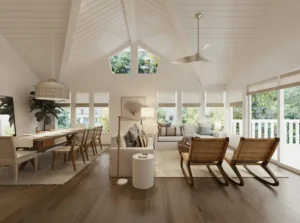Minimalistic interior design is all about simplicity, functionality, and clean lines. It’s a style that has become increasingly popular in recent years and for a good reason. When paired with geometric patterns, minimalistic design can create a striking and stylish space.
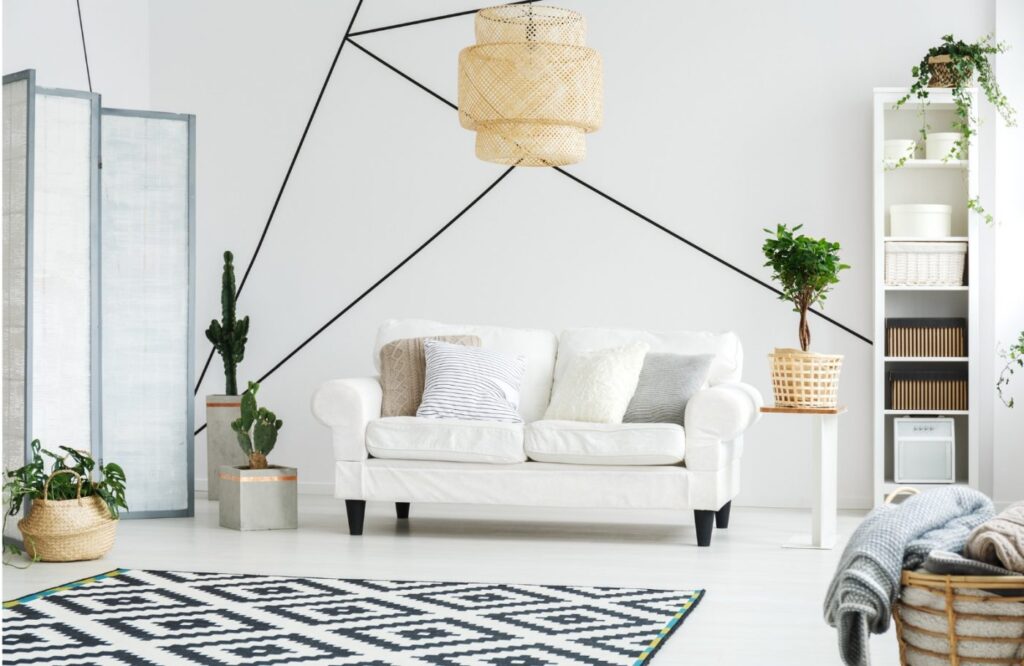
What We'll Cover
ToggleThe Basics of Minimalistic Interior Design
Minimalistic interior design is characterized by its emphasis on functionality and simplicity. This style is all about clean lines, neutral colors, and uncluttered spaces. When it comes to furniture, minimalistic design favors simple, sleek pieces with a focus on functionality.
Adding Geometric Patterns to Minimalistic Design
Geometric patterns can add a new level of interest and depth to a minimalistic space. When used correctly, geometric patterns can create a focal point without overwhelming the simplicity of the room.
One way to incorporate geometric patterns into a minimalistic space is through the use of accent pieces. Consider adding geometric patterned throw pillows or an area rug to a space that is otherwise devoid of patterns.
Choose a Focal Point with Geometric Patterns in Minimalist Design

Instead of painting a whole room a bold color, create a statement wall with a geometric pattern. This can be done using wallpaper, stencils, or even a DIY paint job. A statement wall can add interest to an otherwise minimalistic space, without overpowering it. When adding geometric patterns to a minimalist space, it’s important to choose a focal point. This could be a patterned rug, a piece of artwork, or even a geometric-patterned accent wall. By choosing a single focal point, you can add interest to the space without overwhelming it with too many patterns.
Stick to a Neutral Color Palette with Geometric Patterns in Minimalist Design
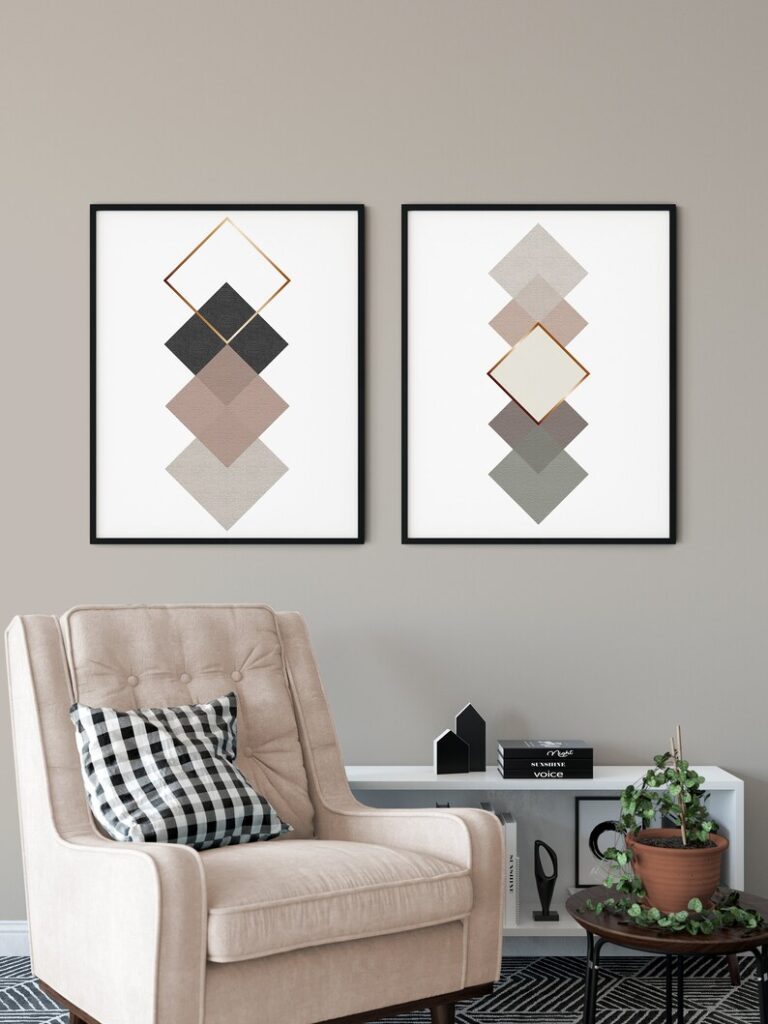
Minimalistic design often features a neutral color palette, and this can also apply to the use of geometric patterns. Stick to neutral colors like white, black, gray, or beige when choosing your patterned pieces. This will keep the space feeling calm and serene, while still adding interest with the pattern.
Use Geometric Shapes in Furniture and Decor for Minimalist Design

Another way to incorporate geometric patterns into your minimalist space is by using geometric shapes in your furniture and decor. This could be a coffee table with a geometric base, or even a simple vase with a geometric pattern. These small touches can add visual interest without overwhelming the space.
Mix and Match Geometric Patterns in Minimalist Design

When adding geometric patterns to a minimalist space, consider mixing materials. For example, a geometric-patterned wood coffee table can add warmth and texture to a space, while a geometric-patterned metal side table can add a cool industrial touch. If you want to incorporate more than one pattern into your minimalist space, make sure to mix and match carefully. Stick to patterns with similar shapes and color schemes, and use them sparingly throughout the space. For example, you could pair a geometric-patterned rug with a few geometric-patterned throw pillows, while keeping the rest of the space neutral.
Add Texture with Geometric Patterns in Minimalist Design

Another way to incorporate geometric patterns into your minimalist space is through the use of textured walls. A wall with a geometric patterned texture can add interest and depth to the space, without adding any color or overwhelming the minimalist aesthetic.
Lighting Fixtures and Adding Geometric Patterns to Minimalist Spaces

Incorporate geometric patterns into your lighting fixtures. For example, a pendant light with a geometric shade can add visual interest to a space without adding any color. You could also use a lamp with a geometric base to add a subtle touch of pattern to a room.
Layering Patterns and Creating Visual Interest with Geometric Patterns in Minimalist Design

Don’t be afraid to layer patterns in a minimalist space. For example, a geometric patterned rug can be paired with patterned throw pillows or a patterned throw blanket. When layering patterns, make sure to stick to a similar color scheme and keep the rest of the space neutral.
Adding Geometric Patterns to Minimalist Spaces Through Soft Furnishings

Textiles are an easy way to add geometric patterns to a minimalist space. Consider incorporating a geometric patterned throw blanket, curtains, or even a table runner into your space. Textiles are an easy way to switch up the pattern in a space and add visual interest.
Geometric Patterns for Different Minimalist Spaces
Minimalist design is often characterized by its clean lines and simple color palettes. However, adding geometric patterns can help to add visual interest and texture to the space. Here are some tips for incorporating geometric patterns into different minimalist spaces:
Entryway: Creating a Welcoming Space with Geometric Patterns
The entryway is the first impression your guests have of your home, so adding geometric patterns can create a welcoming and stylish space. Here are some ideas for incorporating geometric patterns into your entryway:
- Use a geometric-patterned rug or doormat to create a focal point.
- Add geometric-patterned hooks or a key holder to keep the space organized.
- Choose geometric-patterned artwork or wall decor to add visual interest to your space.
Living Room: Incorporating Geometric Patterns in Furniture and Decor
The living room is often the main gathering space in the house, and incorporating geometric patterns can help to make it more visually appealing. Here are some ways to add geometric patterns to your living room:
- Start with a geometric-patterned rug as the focal point of the room. Choose a rug that incorporates colors that complement the rest of the space.
- Add throw pillows with geometric patterns to your couch or chairs. Make sure to choose pillows with patterns that complement the rug.
- Choose a coffee table with a geometric base, or add geometric-shaped decor to your shelves or walls.
Décor tip: When incorporating geometric patterns in your living room, make sure to keep the rest of the space neutral to avoid overwhelming the room.
Kitchen: Adding Geometric Patterns with Backsplashes and Tiles
The kitchen is another space where geometric patterns can add interest and texture. Here are some ways to incorporate geometric patterns into your kitchen:
- Use geometric-patterned tiles for your backsplash. This is a great way to add visual interest to a space that is often overlooked.
- Choose geometric-patterned dishware or cups to display on open shelving or in glass-front cabinets.
- Add a geometric-patterned rug or runner in front of the sink or under the kitchen table.
Décor tip: Remember to stick to a neutral color palette when incorporating geometric patterns into your kitchen.
Bedroom: Enhancing a Minimalist Bedding with Geometric Patterns
The bedroom is a space where you can add subtle geometric patterns to enhance your minimalist bedding. Here are some ideas for adding geometric patterns to your bedroom:
- Choose a geometric-patterned throw pillow or blanket to place on your bed.
- Add geometric-patterned curtains to your windows.
- Use a geometric-patterned rug to add texture to your floor.
Décor Tip: When incorporating geometric patterns into your bedroom, make sure to choose patterns that complement the existing color scheme of the space.
Bathroom: Adding Geometric Patterns with Tiles and Textiles
The bathroom is a space where you can use geometric patterns to create a sense of depth and texture. Here are some ways to incorporate geometric patterns into your bathroom:
- Use geometric-patterned tiles on the floor or walls of your shower or tub area.
- Add a geometric-patterned shower curtain or bath mat to your space.
- Choose geometric-patterned towels or bathrobes to display on hooks or shelves.
Décor tip: When incorporating geometric patterns into your bathroom, make sure to choose patterns that complement your existing color scheme.
Home Office: Using Geometric Patterns in Furniture and Decor
The home office is a space where you can add geometric patterns to create a modern and stylish environment. Here are some ideas for incorporating geometric patterns into your home office:
- Choose a geometric-patterned desk or chair to serve as the focal point of the room.
- Add geometric-patterned storage boxes or file folders to your shelves or filing cabinets.
- Use geometric-patterned art or wall decor to add visual interest to your space.
Décor tip: When incorporating geometric patterns into your home office, make sure to choose patterns that complement your existing design aesthetic.
The Benefits of Minimalistic Design and Geometric Patterns
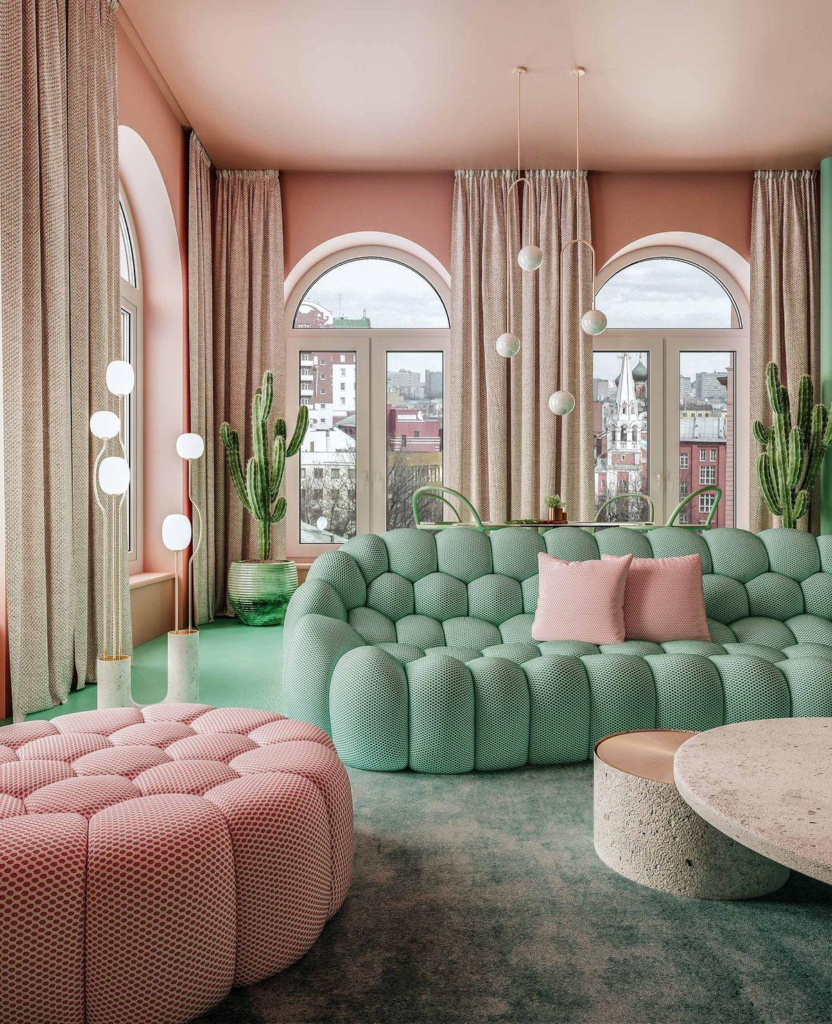
The Magic of Geometric Patterns in Elevating Minimalist Decor
Minimalist decor can often feel stark and clinical, but geometric patterns have the power to inject some much-needed visual interest and texture into a space. Here’s how:
- Visual interest: Geometric patterns add depth and dimension to a minimalist space without overwhelming it.
- Cohesive design: Using a consistent color palette with geometric patterns can tie together a minimalist space and make it feel more polished.
- Contrast: The contrast between neutral minimalist elements and bold geometric patterns creates a dynamic and energetic atmosphere.
- Enhanced functionality: Geometric patterns can be used to enhance the functionality of a space, creating a defined seating area or accent wall.
- Modern touch: Geometric patterns have a contemporary feel that can bring a minimalist space up to date and make it feel fresh.
That’s a Wrap:
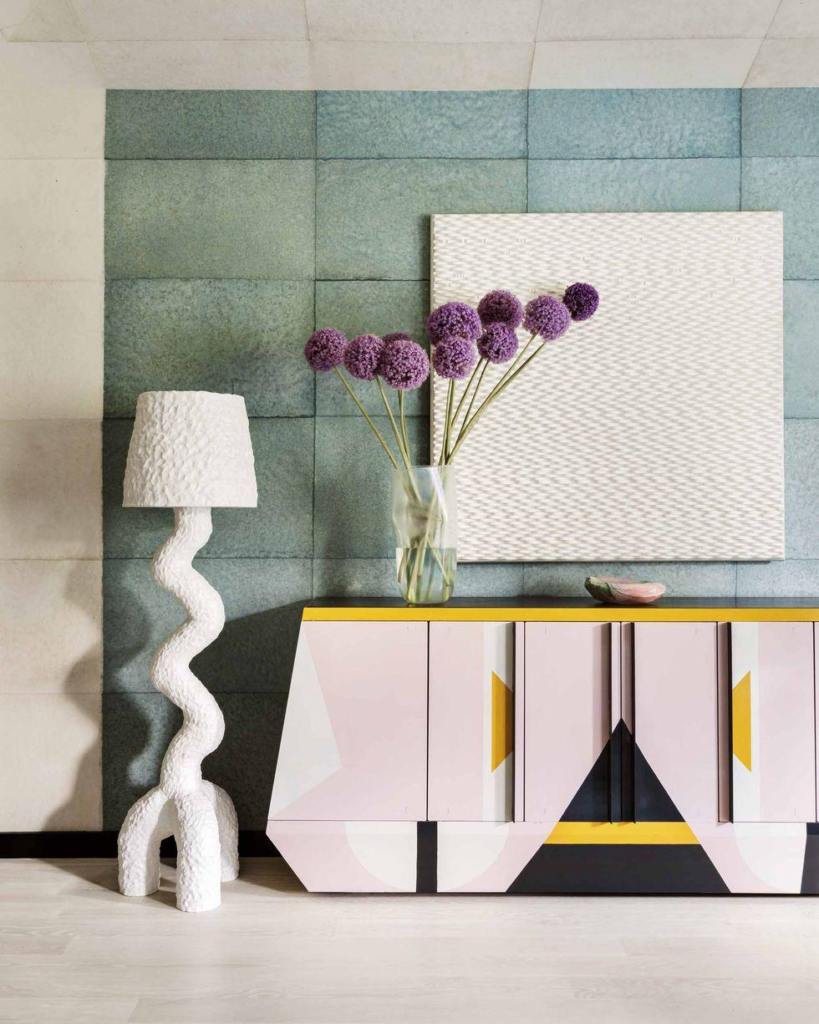
The combination of minimalistic design and geometric patterns offers many benefits. First and foremost, it creates a striking and stylish space that is both functional and aesthetically pleasing. Minimalistic design with geometric patterns also offers a sense of calm and serenity. The clean lines and neutral colors create a peaceful environment that is easy on the eyes. Finally, this combination is also easy to maintain. With fewer pieces of furniture and fewer patterns to worry about, minimalistic design with geometric patterns is a breeze to clean and organize.
Whether you’re looking to spruce up your living room, kitchen, bedroom, or any other space, remember the magic of geometric patterns in minimalist design. With a little bit of thought and creativity, you can transform your space into a beautiful and functional oasis that you’ll love coming home to. With this dynamic duo in your decor arsenal, the possibilities are endless. So go forth and create your perfect minimalist space with the magic of geometric patterns.
And with that, it’s a wrap! Let’s bring down the curtains on this celebration of geometric patterns and minimalist design. Happy decorating!
FAQs
Geometric patterns in minimalistic interior design can encompass both two-dimensional and three-dimensional elements. Contrary to popular belief, these patterns are not limited to sharp, angular lines. They can also incorporate smooth curves such as circles, ovals, and crescents. In fact, circles and curves hold equal geometric significance as triangles, squares, and hexagons. Let go of the misconception that geometric shapes in interior design are solely characterized by strong, cutting lines.
Minimalist interior design shares striking similarities with modern interior design, as it focuses on utilizing only essential elements to establish a straightforward and uncluttered atmosphere. This style is defined by its emphasis on simplicity, clean lines, and a predominantly monochromatic color scheme, where color is sparingly employed to provide accent and visual interest.
Geometric patterns possess significant visual impact, making them exceptionally well-suited for area rugs. By placing a bold and eye-catching graphic print on a rug, you immediately establish a focal point that grounds and enhances the overall design of your space. You can utilize a geometric rug to unify the color scheme of the room, introduce texture, or create a captivating contrast with smaller, more organic patterns present in the surrounding decor.
Minimalist design spaces are characterized by their adherence to clean, uncluttered lines, minimal embellishments, a subdued palette of neutral colors, and the use of natural materials.

